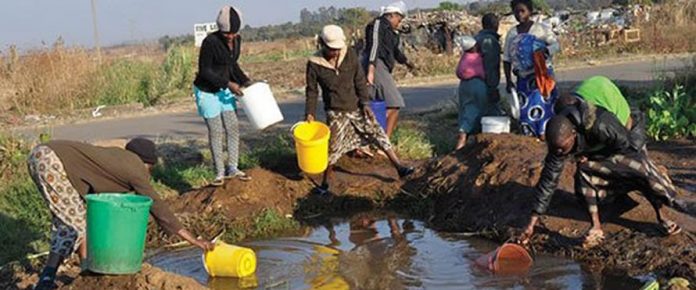Farai Mabeza
Only 37% of the Zimbabwean population use basic sanitation facilities, a 2019 survey has reported.
According to the 2019 Multiple Indicator Cluster Survey done by the Zimbabwe National Statistics Agency (Zimstat) 43% of people in urban areas used basic sanitation services compared to 34% in rural areas.
“Slightly above 6 in 10 of the population had basic drinking water services. 92% in urban areas and 51% in rural areas,” the survey report said.
The proportion of the urban population using limited sanitation services was 56%.
Of the households without water on premises, 87% in urban areas, on average, spent up to 30 minutes fetching water per day while in rural 54% spent between 31 minutes to three hours.
The same survey found that almost 9 in 10 households owned a mobile phone; while 2 in 5 owned a radio; 36% owned a television set, 15% owned a computer and a mere 2% owned a fixed telephone line.
About 3 in 10 households had access to internet at home while mobile phone usage was very high for both women (90%) and men (89%). More men (36%) used the internet compared to women (27%).
“Men were almost twice more likely to possess computer skills than women, 22% and 13%, respectively,” Zimstat said.
Neonatal Mortality Rate was 32 deaths per 1 000 live births for the 5 years preceding the survey and has remained unchanged over the past 15 years.
Infant Mortality Rate was 47 deaths per 1 000 live births for the 5 years preceding the survey while the under- 5 mortality rate was 65
Males age 10-19 years constitute 25% of the male population and females 21% of the total female population.
A higher proportion of discriminatory attitudes towards people living with HIV was reported amongst the age groups of 15- 24 years, among men (45%) and among women (40%).
The proportion of individuals 15 -49 years of age tested for HIV in the 12 months preceding the survey and knew their results was 61% in women and 47% in men.
In the age group 15–24 years, the proportion of sexually active women was 52% and that of men was 40%.
The proportion of adolescent boys and young men age 15-24 years who reported having had sex before the age of 15 years was 6% and for girls and young women of the same age group was 4%.
About 1 in 4 children under 5 were stunted and at risk of impaired physical and cognitive growth.
“This is still ranked ‘High’ according to the WHO thresholds for prevalence of stunting. There is a noteworthy increase in stunting from the age of 9 months, with a peak at 18 month (60%) and a gradual decrease to 18% at 59 months,” Zimstat said.
The prevalence of stunting was higher in rural areas (26%) compared to urban (19%), children in poorest households (28%) are twice more likely to be stunted than those in richest (14%). The highest prevalence of stunting was in Manicaland (31%) while the least was in Harare (19%).
School attendance to an Early Childhood Education programme or primary school (1 year prior to primary school entry age) was 81%.
Upper secondary school net attendance was very low (9%). Primary school net attendance was very high (91%) compared to lower secondary school net attendance (60%). Lower secondary school net attendance was lowest in Matabeleland North province (43%).
Boys have a higher attendance rate in rural areas than girls whilst girls attendance is (slightly) higher than that of boys in the urban areas while 22 percent of adolescent girls age 15-19 years reported having been excluded from activities (social activities, school or work) due to their last menstruation in the last 12 months.
One in three of the boys age 5-17 years and one in five of girls in the same age group were in child labour. Thirteen percent of children age 5-17 years were working under hazardous conditions.
Rural urban disparities exist in Zimbabwe. Two in five women age 20-24 got married before age 18 in rural areas compared to one in five urban areas
Education and socio- economic status are key determinants of child marriage. Women age 20-49 years with pre-primary or no education were 13 times more likely to get married by age 18 compared to those with higher education while women in poor households were almost four times more likely to get married by age 18 compared to those from rich households.
About 2 in 5 women reported ever having experienced either physical or sexual violence whilst one in ten reported having experienced both.
Provinces that reported the lowest prevalence of spousal sexual violence were Matabeleland North (5%), Matabeleland South (6%) and Bulawayo (7%).
The top three provinces where women reported having experienced all forms of spousal violence were Mashonaland East (55%), Masvingo (54%) and Manicaland (53%).









